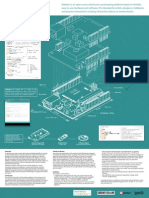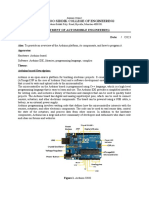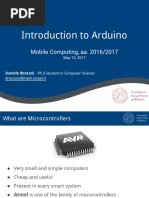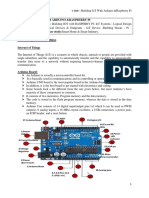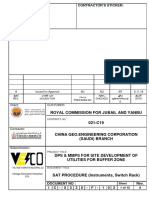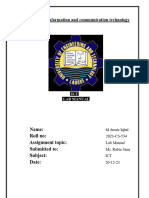Defining Arduino
Uploaded by
Diksha NageshwarDefining Arduino
Uploaded by
Diksha NageshwarDefining Arduino
An Arduino is actually a microcontroller based kit which can be either used
directly by purchasing from the vendor or can be made at home using the
components, owing to its open source hardware feature. It is basically used
in communications and in controlling or operating many devices. It was
founded by Massimo Banzi and David Cuartielles in 2005.
Defining Arduino
An Arduino is actually a microcontroller based kit which can be either used
directly by purchasing from the vendor or can be made at home using the
components, owing to its open source hardware feature. It is basically used
in communications and in controlling or operating many devices. It was
founded by Massimo Banzi and David Cuartielles in 2005.
Arduino Architecture:
Arduino’s processor basically uses the Harvard architecture where the
program code and program data have separate memory. It consists of two
memories- Program memory and the data memory.The code is stored in the
flash program memory, whereas the data is stored in the data memory. The
Atmega328 has 32 KB of flash memory for storing code (of which 0.5 KB is
used for the bootloader), 2 KB of SRAM and 1 KB of EEPROM and operates
with a clock speed of 16MHz.
Arduino
Architecture
Arduino Pin Diagram
A typical example of Arduino board is Arduino Uno. It consists of
ATmega328- a 28 pin microcontroller.
Arduino Pin
Diagram
Arduino Uno consists of 14 digital input/output pins (of which 6 can be used
as PWM outputs), 6 analog inputs, a 16 MHz crystal oscillator, a USB
connection, a power jack, an ICSP header, and a reset button
Power Jack: Arduino can be power either from the pc through a USB or
through external source like adaptor or a battery. It can operate on a external
supply of 7 to 12V. Power can be applied externally through the pin Vin or
by giving voltage reference through the IORef pin.
Digital Inputs: It consists of 14 digital inputs/output pins, each of which
provide or take up 40mA current. Some of them have special functions like
pins 0 and 1, which act as Rx and Tx respectively , for serial communication,
pins 2 and 3-which are external interrupts, pins 3,5,6,9,11 which provides
pwm output and pin 13 where LED is connected.
Analog inputs: It has 6 analog input/output pins, each providing a resolution
of 10 bits.
ARef: It provides reference to the analog inputs
Reset: It resets the microcontroller when low.
Few of basic Adruino functions are:
digitalRead(pin): Reads the digital value at the given pin.
digitalWrite(pin, value): Writes the digital value to the given pin.
pinMode(pin, mode): Sets the pin to input or output mode.
analogRead(pin): Reads and returns the value.
analogWrite(pin, value): Writes the value to that pin.
serial.begin(baud rate): Sets the beginning of serial communication by
setting the bit rate.
Reasons why Arduino is being preferred these days
1. It is inexpensive
2. It comes with an open source hardware feature which enables users to
develop their own kit using already available one as a reference source.
3. The Arduino software is compatible with all types of operating systems like
Windows, Linux, and Macintosh etc.
4. It also comes with open source software feature which enables
experienced software developers to use the Arduino code to merge with
the existing programming language libraries and can be extended and
modified.
5. It is easy to use for beginners.
6. We can develop an Arduino based project which can be completely stand
alone or projects which involve direct communication with the software
loaded in the computer.
7. It comes with an easy provision of connecting with the CPU of the
computer using serial communication over USB as it contains built in
power and reset circuitry.
You might also like
- Embedded C Basic Lab Manual 21EC481 by RAGHUNATH100% (10)Embedded C Basic Lab Manual 21EC481 by RAGHUNATH33 pages
- Embedded Systems Lecture 5 Board Based Embedded SystemNo ratings yetEmbedded Systems Lecture 5 Board Based Embedded System79 pages
- Arduino Training Course Outline With LectureNo ratings yetArduino Training Course Outline With Lecture19 pages
- Name ID Course Section Term Paper: Arshman Shahbaz F2019376001 DLD Y1 ArduinoNo ratings yetName ID Course Section Term Paper: Arshman Shahbaz F2019376001 DLD Y1 Arduino11 pages
- 01 - Laboratory - Exercise - 1 (15) Arduino-1No ratings yet01 - Laboratory - Exercise - 1 (15) Arduino-17 pages
- CSE 3009 Internet of Things FALL 20-21: Dr. M.Sudha Associate Professor School of Information Technology & EngineeringNo ratings yetCSE 3009 Internet of Things FALL 20-21: Dr. M.Sudha Associate Professor School of Information Technology & Engineering36 pages
- E Book Ultimate+Home+Automation+Using+Advance+AI+Assistant+JARVISNo ratings yetE Book Ultimate+Home+Automation+Using+Advance+AI+Assistant+JARVIS22 pages
- Arduino Programming For ESD: by MD - Dedarul Hasan100% (1)Arduino Programming For ESD: by MD - Dedarul Hasan38 pages
- V: Building Iot With Arduino &raspberry Pi: VunitNo ratings yetV: Building Iot With Arduino &raspberry Pi: Vunit41 pages
- Lecture 5 Course Project. Arduino Basics.: IAT267 Introduc:on To Technological SystemsNo ratings yetLecture 5 Course Project. Arduino Basics.: IAT267 Introduc:on To Technological Systems51 pages
- 66d172a85346099e4be9ec9e IOT102 INTRODUCTIONNo ratings yet66d172a85346099e4be9ec9e IOT102 INTRODUCTION24 pages
- Core Processors 14th Gen Nex InfographicNo ratings yetCore Processors 14th Gen Nex Infographic1 page
- 17 Microprocessor Systems Lecture No 17 JMP and LOOP Instructions PDFNo ratings yet17 Microprocessor Systems Lecture No 17 JMP and LOOP Instructions PDF12 pages
- Royal Commission For Jubail and Yanbu 021-C19: Document No: Rev. I C - 0 3 3 0 - F - 1 0 2No ratings yetRoyal Commission For Jubail and Yanbu 021-C19: Document No: Rev. I C - 0 3 3 0 - F - 1 0 212 pages
- Electric Thrust Actuator ARI-PREMIO - Plus 2G: Data Sheet 000033 Englisch (English)No ratings yetElectric Thrust Actuator ARI-PREMIO - Plus 2G: Data Sheet 000033 Englisch (English)16 pages
- Manual Lian Li PC 8fia - PDF - en - 5929411No ratings yetManual Lian Li PC 8fia - PDF - en - 59294112 pages
- PLC Proworx32 Software User Manual v1.0No ratings yetPLC Proworx32 Software User Manual v1.0326 pages
- Sample CXML Purchase Order With Annotations100% (1)Sample CXML Purchase Order With Annotations2 pages
- Application of Information and Communication Technology: Name: Roll No: Assignment Topic: Submitted To: Subject: DateNo ratings yetApplication of Information and Communication Technology: Name: Roll No: Assignment Topic: Submitted To: Subject: Date101 pages
- Delta PLC Communication Cables Pin Diagram RS-485No ratings yetDelta PLC Communication Cables Pin Diagram RS-48532 pages
- Operating System final notes BCA 3 sem AKKNo ratings yetOperating System final notes BCA 3 sem AKK124 pages
- Manual On Primary & Secondary Storage DevicesNo ratings yetManual On Primary & Secondary Storage Devices12 pages





















